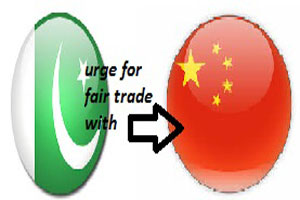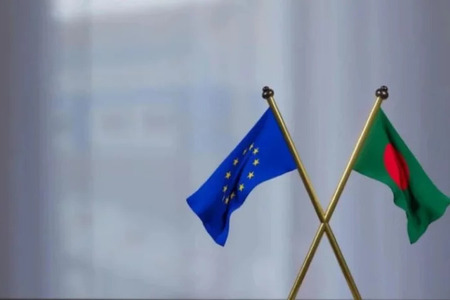
MoC urged to negotiate fair trade deal instead of FTA with China
YarnsandFibers News Bureau 2015-10-09 15:00:00 – IslamabadThe FTA inked between the two countries China and Pakistan on November 24, 2006 is currently undergoing a review to finalise phase-II in which both parties are aiming to eliminate tariff on no less than 90% of the products both in terms of tariff lines and trade volumes. The second phase of China Pakistan Free Trade Agreement (CPFTA) will be held on October 14, 2015 in Beijing.
In the phase-I Pakistan had offered market access to China namely on machinery, organic and inorganic chemicals, fruits & vegetables, medicines and other raw material for various industries including engineering sector, intermediate goods for engineering etc.
However, Pakistan's industrial stakeholders are reportedly urging the Ministry of Commerce (MoC) to negotiate "Fair Trade Agreement" instead of under-negotiated Free Trade Agreement-II (FTA-II), allowing import of raw materials not finished products. This was the crux of the recent consultative meetings between the Commerce Ministry's team and industry representatives held in Islamabad.
In view of mixed reaction to phase-I of the FTA, Ministry of Commerce is working to address the concerns of Pakistan's industry and trade on this agreement. During the review of phase-I, the discrepancy in reported figures between the two countries has been a major source of concern for the policymakers and the trade and industry representatives.
For example, in its report on Pak-China FTA, Pakistan Business Council (PBC) has quoted figures of exports from China to Pakistan at $11.019 billion in 2013. However during the same period, Pakistan recorded imports of only $6.626 billion. This has created an 'unaccounted for' gap of $4.393 billion. Similarly, recorded exports of Pakistan to China are $2.652 billion while during the same period i.e. 2013, China recorded imports of $3.196 billion giving a gap of $544 million. One of the reasons for such discrepancies in trade figures is massive under invoicing and smuggling of goods from China.
Commerce Minister Engineer Khurram Dastgir, is seriously concerned about unaccounted for gap of about $5 billion. He recently met with his Chinese counterpart and urged him to resolve this issue. During the 4thmeeting of negotiation of 2nd phase of CPFTA held in Beijing from 31st Mach to 1st April, 2015 Pakistan shared its concerns regarding insufficient utilisation of concessions given by China to Pakistan and competition faced by the local industries due to cheap imports from China. It was agreed that the tariff reduction modalities of 2nd phase would be designed in a way that all the genuine concerns of the two countries are adequately accommodated.
During the review sessions, conducted by the MoC, common concern shared by the domestic industry has been massive hemorrhage because of unfair advantage that Chinese goods have in Pakistan against the local industry. Support of Chinese government for its own industry through financial and non-financial measures, huge economies of scale that Chinese industry enjoys and lack of implementation of tariffs and import procedures at Pakistani borders are some of the major contributing factors that are disadvantaging Pakistani industry. Pakistan's economy is uncompetitive vis-Ã -vis China due to lack of essential infrastructure, such as gas, electricity and exorbitant cost of other services.
The industry representatives raised serious concerns over allowing further reduction in tariff at a time when Pakistan has been unable to enjoy any increase in exports that can specifically be linked to FTA with China.
The minister has been giving a patient hearing to all sectors and the negotiations are planned to continue through next week, giving the Pakistani side insight and material to negotiate a better deal this time.
Emerging theme behind reducing sensitive list during discussion on second phase of Pak-China FTA is to allow import of those products of different sectors that are not being manufactured locally. However, potential of such products to be produced locally in future is also being discussed. It has been realised that by allowing these products to be imported at a lower or no tariff, the future opportunity for producing locally will be lost. Emerging theme seems to be to allow import of raw-materials in FTA while placing finished/ semi finished product in 'no concession list'.
Industry is eagerly looking forward to a favourable outcome of these negotiations, as the future of manufacturing in Pakistan will depend on the success of Pakistan's negotiating team. In essence, the negotiating team from Pakistan and the industry are looking for "Fair Trade Agreement" instead of 'Free Trade Agreement' so that county's interest may be protected in term of gains of trade.
Pakistan's major exports to China are cotton yarn/fabric, rice, raw hides & skins, crude vegetable material, chemical material, fish and fish preparations and crude mineral etc. While major imports from China are machinery (all sorts) and parts, fertiliser manufactured, chemical element, yarn and thread of synthetic fiber, iron and steels, chemical material and product, vegetable and synthetic textile fiber, road vehicles and their parts, non-ferrous metals, tyres and tubes of rubber etc. Pakistan secured market access on products of immediate export interest like cotton fabrics, blended fabrics, synthetic yarn and fabrics, knit fabrics, home textiles, minerals, sports goods, cutlery, surgical goods, kinnow, mangoes, industrial alcohol, etc.
Market Intelligence
Ask for free sample Report

experience
Customer Base
dedicated team
Countries Served Worldwide




![Freitag unveils new Mono[P6] circular backpack](https://www.yarnsandfibers.com/wp-content/uploads/2024/04/Freitag.jpg)




